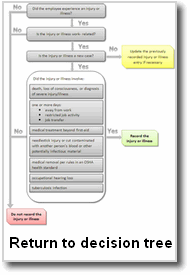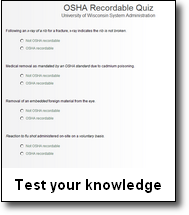Coordinators
Basic definition
If an employee’s hearing test (audiogram) reveals that the employee has experienced a work-related Standard Threshold Shift (STS) in hearing in one or both ears, and the employee’s total hearing level is 25 decibels (dB) or more above audiometric zero (averaged at 2000, 3000, and 4000 Hz) in the same ear(s) as the STS, then the case must be categorized as OSHA recordable.
More detail
(1) What is a Standard Threshold Shift?
A Standard Threshold Shift, or STS, is defined by OSHA as a change in hearing threshold, relative to the baseline audiogram for that employee, of an average of 10 decibels (dB) or more at 2000, 3000, and 4000 hertz (Hz) in one or both ears.
(2) How do I evaluate the current audiogram to determine whether an employee has an STS and a 25-dB hearing level?
(i) STS. If the employee has never previously experienced a recordable hearing loss, you must compare the employee’s current audiogram with that employee’s baseline audiogram. If the employee has previously experienced a recordable hearing loss, you must compare the employee’s current audiogram with the employee’s revised baseline audiogram (the audiogram reflecting the employee’s previous recordable hearing loss case).
(ii) 25-dB loss. Audiometric test results reflect the employee’s overall hearing ability in comparison to audiometric zero. Therefore, using the employee’s current audiogram, you must use the average hearing level at 2000, 3000, and 4000 Hz to determine whether or not the employee’s total hearing level is 25 dB or more.
(3) May I adjust the current audiogram to reflect the effects of aging on hearing?
Yes. When you are determining whether an STS has occurred, you may age adjust the employee’s current audiogram results by using Tables F-1 or F-2, as appropriate, in Appendix F of 29 CFR 1910.95. You may not use an age adjustment when determining whether the employee’s total hearing level is 25 dB or more above audiometric zero.
(4) Do I have to record the hearing loss if I am going to retest the employee’s hearing?
No, if you retest the employee’s hearing within 30 days of the first test, and the retest does not confirm the recordable STS, you are not required to categorize the case as OSHA recordable on the OSHA tab. If the retest confirms the recordable STS, you must record the hearing loss illness within seven calendar days of the retest. If subsequent audiometric testing indicates that an STS is not persistent, you may erase or line-out the recorded entry.
(5) Are there any special rules for determining whether a hearing loss case is work-related?
No. You must use the rules in § 1904.5 to determine if the hearing loss is work-related. If an event or exposure in the work environment either caused or contributed to the hearing loss, or significantly aggravated a pre-existing hearing loss, you must consider the case to be work related.
(6) If a physician or other licensed health care professional determines the hearing loss is not work-related, do I still need to record the case?
If a physician or other licensed health care professional determines that the hearing loss is not work-related or has not been significantly aggravated by occupational noise exposure, you are not required to consider the case work-related or to categorize the case as OSHA recordable on the OSHA tab.
Other references
OSHA Recordkeeping Handbook: For more information on recording criteria for cases of hearing loss.


